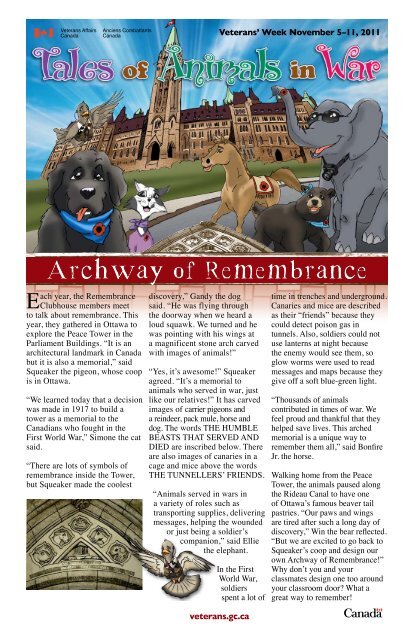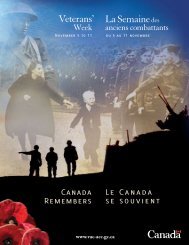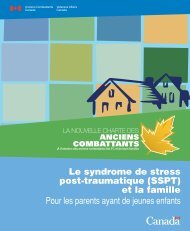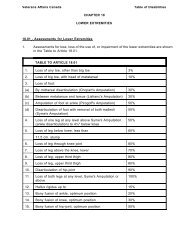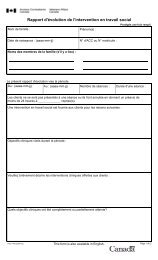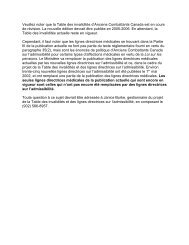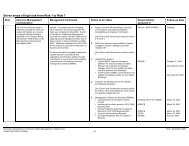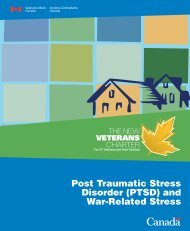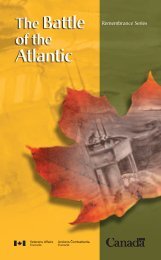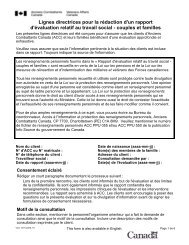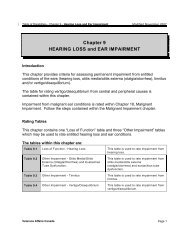Tales of Animals in War
Tales of Animals in War
Tales of Animals in War
- No tags were found...
You also want an ePaper? Increase the reach of your titles
YUMPU automatically turns print PDFs into web optimized ePapers that Google loves.
Remembrance Clubhouse Family TreeCanadians all have different family backgrounds. Here are our brave ancestors.Do you know yours?Dur<strong>in</strong>gthe First World<strong>War</strong>, my relative Bonfirewas the best friend <strong>of</strong> aCanadian doctor and poet namedJohn McCrae. Bonfire carried thedoctor to the battlefield. Sadly, Dr.McCrae died <strong>in</strong> 1918. Bonfireproudly took part <strong>in</strong> hismilitary funeralprocession.Beachcomber be<strong>in</strong>g presentedwith his Dick<strong>in</strong> Medal.My relativeBeachcomber was a carrierpigeon dur<strong>in</strong>g the Second World <strong>War</strong>.He delivered important messages forCanadian soldiers. The messageswere rolled up and put <strong>in</strong> aconta<strong>in</strong>er attached to hisleg. He received the Dick<strong>in</strong>Medal for his courage. Hewas no chicken!Brita<strong>in</strong>’s People’s Dispensary for Sick <strong>Animals</strong>.Courtesy <strong>of</strong> Guelph Museums, McCrae HouseJohn McCrae on Bonfire.Harry Colebourn andW<strong>in</strong>nie <strong>in</strong> 1914.Myrelative was a bearcub. She was adopted as a mascotby a soldier from W<strong>in</strong>nipeg dur<strong>in</strong>gthe First World <strong>War</strong>. He named herW<strong>in</strong>nie! But it was too dangerouson the battlefield for her, so she wentto the London Zoo. While there, she<strong>in</strong>spired an author to write astory . . . W<strong>in</strong>nie the Pooh!Prov<strong>in</strong>cial Archives <strong>of</strong> Manitoba, Colebourn,D. Harry Collection, No. N10467First World <strong>War</strong> elephant.Myrelative Bandoolaserved dur<strong>in</strong>g the SecondWorld <strong>War</strong> <strong>in</strong> Burma, Asia. He andother elephants moved logs to buildbridges. They also carried peopleacross rivers and towed army trucksstuck <strong>in</strong> the mud. I will alwaysremember Bandoola!Illustrated <strong>War</strong> News. February 9, 1916.Dur<strong>in</strong>gthe SecondWorld <strong>War</strong>, my relativeSergeant Gander was amascot <strong>in</strong> Hong Kong. One night,a grenade was thrown at some Canadiansoldiers. Gander knew it was dangerous. Hetook it and ran away. Sadly, the grenadeexploded and Gander died. Hereceived the Dick<strong>in</strong>Medal.Able Seaman Simon and crewfrom the HMS Amethyst.Brita<strong>in</strong>’s People’s Dispensary for Sick <strong>Animals</strong>My relativeSimon served ona British warship <strong>in</strong> 1949.The ship was attacked <strong>in</strong> Ch<strong>in</strong>aand stranded for three months. Manysailors were hurt. Simon was hurt too butkept catch<strong>in</strong>g rats, which saved preciousfood. He also comforted the woundedmen. Simon was presented withthe Dick<strong>in</strong> Medal for hisbravery. What a coolcat!Hong Kong Veterans Commemorative AssociationGander with the Royal Rifles <strong>of</strong> Canadadepart<strong>in</strong>g for Hong Kong <strong>in</strong> 1941.This publication is available upon request <strong>in</strong> other formats. Toll-free: 1-877-604-8469 © Her Majesty the Queen <strong>in</strong> Right <strong>of</strong> Canada, represented by the M<strong>in</strong>ister <strong>of</strong> Veterans Affairs, 2011. Catalogue No.: V32-179/2-2011 Pr<strong>in</strong>ted <strong>in</strong> Canada2 veterans.gc.ca
Loveable MascotsDND ARMY 23177 and DVA 519-16Private P.T. Leachman with the donkeymascot <strong>of</strong> the Saskatoon Light Infantry.My relative W<strong>in</strong>nie was a loveablemascot for a group <strong>of</strong> Canadiansoldiers dur<strong>in</strong>g the First World<strong>War</strong>. Mascots represent groupsDid you know that many animals,like my ancestor Bandoola, havetransported supplies dur<strong>in</strong>g wartime<strong>in</strong> areas where vehicles couldn’ttravel over rough terra<strong>in</strong>?In the First World <strong>War</strong>, horses <strong>of</strong>tentransported soldiers and cannons<strong>in</strong>to battle. Donkeys and mulescarried supplies <strong>in</strong> mounta<strong>in</strong>ousItaly and <strong>in</strong> the jungles <strong>of</strong> Asiadur<strong>in</strong>g the Second World <strong>War</strong>.or teams. In the military, animalmascots <strong>of</strong>ten serve as pets toprovide fun and friendship.Many animals have served asmascots onboard Canadian ships.Playful dogs like Rags and Jeanniesailed dur<strong>in</strong>g the Second World<strong>War</strong>. Cats and even Muncherthe rabbit also had their “seapaws!” They provided comfort tosailors. Other animals, like Mike,the Sa<strong>in</strong>t Bernard, preferred dryland. He was the mascot <strong>of</strong> theAlgonqu<strong>in</strong> Regiment dur<strong>in</strong>gthe Second World <strong>War</strong>.Sometimes, they even gave tiredsoldiers a ride! Re<strong>in</strong>deer and camelsdid the same <strong>in</strong> the snowy Arcticand the arid desert.Elephants, strong and smart like me,carried supplies and helped to buildroads and camps <strong>in</strong> the jungles <strong>of</strong>Burma dur<strong>in</strong>g the Second World<strong>War</strong>.Brave beasts always pull theirweight!Mascots come<strong>in</strong> various shapes and sizes. Adonkey served as the mascot<strong>of</strong> the Saskatoon LightInfantry <strong>in</strong> Sicily <strong>in</strong> 1943.Batisse the goat, represent<strong>in</strong>gthe Royal 22 e Régiment,patrols the Citadelle, <strong>in</strong>Québec City. Today, theCanadian Army’s mascot isJuno, a cuddly life-size teddybear.Mascots, real or stuffed,always rally the troops! Doesyour school have a mascot?Movers and ShakersPack horses transport<strong>in</strong>g ammunition for theCanadian Field Artillery, April 1917.LAC PA-001231Did YouKnow?‘Joe the Crow’ and friend <strong>in</strong> 1950.Crowsnest magaz<strong>in</strong>e photo courtesy <strong>of</strong> CFB Esquimalt Naval &Military MuseumMore than 26,000Canadians took part <strong>in</strong> theKorean <strong>War</strong> between 1950and 1953. These <strong>in</strong>cludedmany brave sailors whoserved on destroyers <strong>of</strong>fthe Korean coast. Several<strong>of</strong> these ships had animalmascots, <strong>in</strong>clud<strong>in</strong>g Alice thedog on the HMCS Cayuga.A Canadian sailor hadrescued the stray pup fromdrown<strong>in</strong>g and she quicklybecame a friend for the men.And sailors back then mighteven have come across “Joethe Crow,” the mascot <strong>of</strong> thenaval tra<strong>in</strong><strong>in</strong>g base HMCSCornwallis <strong>in</strong> Nova Scotia.Colour Me!Diggers and SniffersM<strong>in</strong>e Detection Dogs Fanny and AlexCanadian Landm<strong>in</strong>e FoundationHave you ever heard theexpression, “an animal is a man’sbest friend? ” When war breaksout, it’s not just men and womenwho head <strong>of</strong>f to the battlefields.<strong>Animals</strong> <strong>of</strong>ten go with them.Over the years, animals havehelped Canada’s soldiers <strong>in</strong> manydifferent ways.Like my relative Gander, otheranimals have saved lives dur<strong>in</strong>gwartime. In the First World <strong>War</strong>,mice and canaries would helpthe soldiers who were digg<strong>in</strong>gtunnels by warn<strong>in</strong>g them whenthey smelled dangerous gases.German shepherds, like mycan<strong>in</strong>e friends Fanny and Alex,are very good sniffers. Theyworked with Canada’s army <strong>in</strong>Afghanistan to f<strong>in</strong>d roadsidebombs, explosive landm<strong>in</strong>es andmiss<strong>in</strong>g soldiers.An animal’s nose always knows!The Dick<strong>in</strong> Medal, which wascreated <strong>in</strong> 1943, is awardedto animals for their braveacts. Only 63 animals haveever received the honour: 32pigeons, 27 dogs, three horses,and one cat.The words on the medal say:“For Gallantry” and “We alsoServe.”The ribbon is striped:– green(for water and the naval forces)– dark brown(for earth and the land forces)– pale blue(for air and the air forces)veterans.gc.ca 3
Want to know why a pigeonlike me was up there at the verytop <strong>of</strong> the carv<strong>in</strong>g <strong>in</strong> the PeaceTower? In times before cellphones, text<strong>in</strong>g and Facebook,carrier pigeons deliveredimportant <strong>in</strong>formation becausethey were so good at f<strong>in</strong>d<strong>in</strong>gtheir way from one place toanother. Soldiers would attachnotes to the pigeons and thenDeliver<strong>in</strong>g the Newsrelease them to fly back to theircoops.My ancestor Beachcomber wasthe bird that delivered newsabout the raid <strong>in</strong> Dieppe, France,dur<strong>in</strong>g the Second World <strong>War</strong>.More than 900 Canadians werekilled <strong>in</strong> the difficult attackon the seaside town. A lot <strong>of</strong>carrier pigeons were also useddur<strong>in</strong>g the First World <strong>War</strong>. Ifthe enemy soldiers saw a pigeonfly<strong>in</strong>g by, they would shoot at itbecause they knew it could becarry<strong>in</strong>g an important message.But we pigeons are super speedy.We can fly up to 100 kilometresper hour and that’s why the newsusually got through! Some birdseven delivered their messagesafter be<strong>in</strong>g wounded.Royal Air Force carrier pigeon, 1942.Imperial <strong>War</strong> Museum.The <strong>Animals</strong> <strong>War</strong> Exhibition.Dogs and cats were messengerstoo, carry<strong>in</strong>g <strong>in</strong>formation <strong>in</strong>conta<strong>in</strong>ers around their necks<strong>in</strong> dangerous war zones. Weanimals always deliver!Breakthe CodeMessages carried by pigeons were usually written <strong>in</strong>code <strong>in</strong> case they fell <strong>in</strong>to enemy hands. Put on yourth<strong>in</strong>k<strong>in</strong>g hats and decipher the code to read thissecret message.__ __ __ __ __ __ __ __ __20 8 5 8 21 13 2 12 5__ __ __ __ __ __ __ __ __ __2 5 1 19 20 19 20 8 1 20__ __ __ __ __ __ __ __ __19 5 18 22 5 4 1 14 4__ __ __ __4 9 5 4H<strong>in</strong>t: These words can be found carved <strong>in</strong>side the Peace Tower.Code break<strong>in</strong>g key: A=1, B=2, C=3, etc.Cavalr y Charge!Whoa, partner! I am go<strong>in</strong>g totell you about someth<strong>in</strong>g coolthat animals like me did <strong>in</strong> warslong ago. Horses were used <strong>in</strong>cavalry units, where soldiersfought on horseback. <strong>War</strong> horseshave been used for thousands <strong>of</strong>years, like when knights used toride us <strong>in</strong> the Middle Ages!My ancestor Bonfire knew acouple <strong>of</strong> cavalry horses dur<strong>in</strong>gthe First World <strong>War</strong>. They toldhim that fight<strong>in</strong>g on horsebackon the Western Front was verydifficult because the enemy haddeep trenches, mach<strong>in</strong>e guns,tangles <strong>of</strong> barbed wire andpoison gas. Dr. McCrae used totell Bonfire what it was like <strong>in</strong>the South African <strong>War</strong> back <strong>in</strong>1900. Canadian cavalry forceshad been important <strong>in</strong> thewide-open spaces over there.Imag<strong>in</strong>e how courageous ahorse would have to be tocharge through the gunfire and2 nd Canadian Mounted Rifles onpatrol <strong>in</strong> South Africa <strong>in</strong> 1902.explosions <strong>of</strong> a battle, with asoldier on his back shoot<strong>in</strong>g orsw<strong>in</strong>g<strong>in</strong>g a sword!LAC PA-173029Furry FriendsConnect the Dots!Purr! Cats like me and myancestor Simon are good at<strong>of</strong>fer<strong>in</strong>g furry comfort and af riendly ear to help people feelbetter. Many other k<strong>in</strong>ds <strong>of</strong>animals have been special petsdur<strong>in</strong>g times <strong>of</strong> war, keep<strong>in</strong>gpeople company when theywere far away from home.Lots <strong>of</strong> dogs have been <strong>of</strong>ficialor un<strong>of</strong>ficial pets, and otheranimals like ferrets, squirrels,mice and birds have also beenspecial friends to lonely soldiersover the years. But I haveto say the Canadian Forcesmembers serv<strong>in</strong>g <strong>in</strong> Kandahar,Afghanistan, have a prettyunique pet, a monkey namedLucy!We Remembrance Clubhouseanimals are very proud <strong>of</strong> ourLucy the monkey.Canadian Press / Bill Gravelandbrave relatives. Many Canadianshave served <strong>in</strong> the military anda lot <strong>of</strong> people have their owncourageous family members. Youknow what? I th<strong>in</strong>k you shouldask your parents or grandparentsif they know <strong>of</strong> any relatives,friends or neighbours who haveserved <strong>in</strong> the cause <strong>of</strong> peace andfreedom. Then you can learnabout these real-life heroes foryourself!Lieutenant-Colonel John McCrae and Bonfire4 veterans.gc.ca


